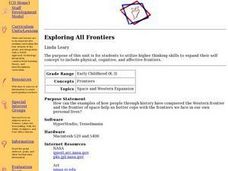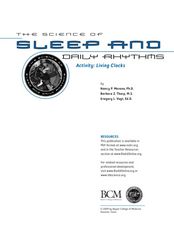Curated OER
Our Solar System
Sixth graders use the internet to examine the different bodies in space. In groups, they select one project they want to complete and are given a timeline for when the sections are due. To end the lesson, they present their information...
Curated OER
Exploring All Frontiers
Young scholars utilize higher thinking skills to expand their self concept to include physical, cognitive, and affective frontiers. The teacher create activities which allow students to use raw data and primary sources, as well as...
Curated OER
Geometry of Radio Meteor Reflections
Ninth graders investigate and describe ways that human understanding of Earth and space has depended on technological development. They describe and interpret the science of optical and radio telescopes, space probes and remote sensing...
Curated OER
Newton's Third Law
Students describe an everyday situation which demonstrates Newton's Third Law. They state Newton's Third Law;"Every action has an equal and opposite re-action, or every force has an equal and opposite force" in their own words. ...
Curated OER
Trivia Tag
Students, as chasers, on teachers signal, move throughout a space trying to tag others with their free hand. When a tag is made, both players stop; chaser reads question from card to student who was tagged. If answer is correct, person...
Curated OER
Alka-Seltzer Rockets: How to Build Your Own Rocket
Students create a rocket using Alka-seltzer of baking soda and vinegar. In this physics lesson, students identify the factors affecting the length of time the rocket is propelled. They relate this activity to actual rocket launched in...
Curated OER
What Do Magnets Do?
Second graders discover the physical properties of magnets. In this physics lesson, 2nd graders investigate the differences between natural and man made magnets and the uses of each. Students complete 4 separate RAFT assignments based...
Curated OER
Animal Adaptations
Fourth graders view slides on the SMART board of physical and behavioral adaptations of animals. In this animal adaptations lesson plan, 4th graders also view a video and match a physical adaptation with the animal it pertains to.
Curated OER
What is ergonomics and why is it important?
Students come up with ideas to help friendly, superintelligent space aliens adapt to this environment.
Curated OER
Best Practices
Students are encouraged to do their best on the mile run portion of the fitness test. They also gain knowledge about fitness in other academic areas of the school too. In science, the class records resting pulse rates, in math, charts...
Curated OER
What is Everything Made of?
Students observe a demonstration on how we see space between water molecules. In this experimental lesson plan students discover what elements make up the things around them and discuss what they learned.
Curated OER
What's "Out" There?
First graders investigate the five outer planets. In this space science lesson, 1st graders read the book Our Solar System and identify the five outer planets. Students create a booklet and write about outer planets.
Curated OER
Habitat Lap Sit
Students examine through role play interdependence of animal and man in their search for the proper arrangement of food, water, shelter and space in the same regions. Students then discuss necessary components of suitable habitat.
Curated OER
Water and Ice
Students explore the physical properties of water. In this water lesson, students observe, measure, and describe water as it changes state. There are 2 extensions for this lesson that one can access via the Internet links provided.
Curated OER
Living Clocks
Students complete experiments to learn about their internal body clocks and physiological activities. In this internal body science lesson, students read "Body Clock Investigations" and complete a body temperature investigation.
Curated OER
Native Plants: An Outdoor Scavenger Hunt
Young scholars recognize various California native species by their physical appearances and characteristics. They recognize the adaptations that plants make to their surroundings and how humans make use of plants.
Curated OER
Free Radicals Attack!!
Pupils review and practice soccer dribbling/ball handling skills while studying basic concepts of how free radicals and antioxidants affect the body. As the molecules move throughout the space with their electron, the free radicals...
Curated OER
"I can move" but why?
Students analyze the movements they can do with their bones, muscles and joints. They explore, have discovery and review knowledge of movement. Students are asked to find their personal space.
Curated OER
Dem Bones
Learners engage in an activity in order to review the skeletal system. They play a game composed of two teams to be played in an open area. Students pick out bones from a bag and place them in the correct space for the skeleton.
Curated OER
Your Weight on Other Planets
Students explore their weight on other planets. For this science lesson, students view a presentation about the other planets and complete a worksheet in which they make predictions about their weight on the moon and other planets.
Curated OER
Seeing Interference Fringes with a Telescope
Students construct an interferometer using a simple telescope. In this physics instructional activity, students explain how light waves create the fringe patterns. They observe patterns made by different objects in the sky and compare them.
Curated OER
The Letter Rr: Alphabet Theme
Students complete several cross-curricular activities to learn the letter Rr. In this letter recognition lesson plan, students complete activities that include geography, music, physical education, science, seasonal, space science, and...
Curated OER
Properties of Air
Students conduct investigations to demonstrate and learn that air takes up space, and puts pressure, or pushes, on everything around it. They conduct experiments to learn about feeling air pressure and measuring air pressure. Prior to...
Curated OER
The Solar System: Why do we Explore?
Third graders act as scientists. In this property discovery lesson, 3rd graders explore the substance "Oobleck" (cornstarch, water, food coloring). They work in groups to investigate the substance and make observations as a scientist...

























